#Writing reference writing Resource
Text
Writing Characters with Glasses

Glasses are one of those components in writing that one just knows whether the writer has any experience with or not from the offset. So how do we write glasses-wearing characters or characters with impaired vision?
What is your character's eye strength?
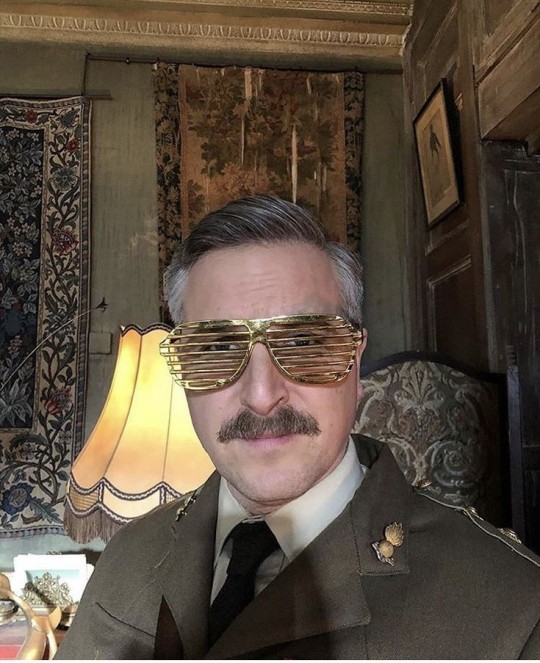
Now, you don't have to know your character's exact diagnoses but you should know what sightedness your character has. Near-sighted means your character has trouble seeing things far way but can see things up close. Far-sightedness means a character can see things better in the distance than they can in before them.
Typically, one eye can be weaker or stronger than another, so a lense may be slightly thicker or slimmer than the other. Myself, my left eye is much weaker than my right.
Wearing Glasses

Typically when you wear glasses, you start to ignore the frames in your peripheral vision, however if you may notice it more if you haven't been wearing your glasses for a while.
Also when you change lenses, your sight is funny for a while. Things, like the fucking ground itself, seem a lot closer which can lead you to feel very disoriented. Its best to break glasses in gradually, in the words of Our Lady, Theresa Manion, "Do not make unnecessary journeys, do not take risks on treacherous roads..."
Glasses can get dirty and smudged very easily and do require cleaning. You may often see somebody wipe their glasses with their shirt tail but this isn't always effective, some fabrics just worsen the issue. Dry tissue paper is the best or a glass cloth. Frames also should be cleaned too.
Glasses tend to fog up when it rains, when you sweat or when you're somewhere steamy or drinking/eating something really hot. It can be a nuisance but it usually won't impair your vision that much.
Glasses can strain your eyes and start to chafe after a while. Long periods of wearing glasses can make your eyes start to ache (it always happens to me) and the best thing to do is just remove them and rest your eyes. The frames can also rub against the tops of your ears or the bridge of your nose.
People who need glasses tend not to remove them very often. If your vision is very bad, you won't be whipping your glasses off at every opportunity like Horatio Caine. If you only need reading glasses or need glasses for specific tasks you, wouldn't wear them 24/7 as it can further damage your eyes (I did this and now I can barely see 4ft ahead of me).
You can do tasks without your glasses but you do feel more cautious, especially if you have difficulty making out details. Glasses usually make you more comfortable in situations.
And as for the whole pushing up glasses when they slip (and they do slip but gradually), there's no right way or wrong way. Personally, I adjust by moving the entire frame between my thumb and forefinger so I don't smudge the lense. But pushing it up by the bar that crosses your nose is also effective.
When you're not wearing glasses

Not wearing glasses isn't delibiltating if your character's sight isn't majorly mad. As I mentioned before, they can still carry out tasks. But not wearing glasses can leave you a little unsure and sometimes disoriented.
Most people can still see without glasses, things just aren't as focused. For me, things get very fuzzy especially if they are far away but I can still make out the shape - for example, I can see how many fingers you're holding up but not your ring. I can do a lot of tasks without glasses.
When you're not wearing your glasses, you do tend to squint which can help you see a little better or tend to lift things to your eyes to see them better.
Characters wearing glasses
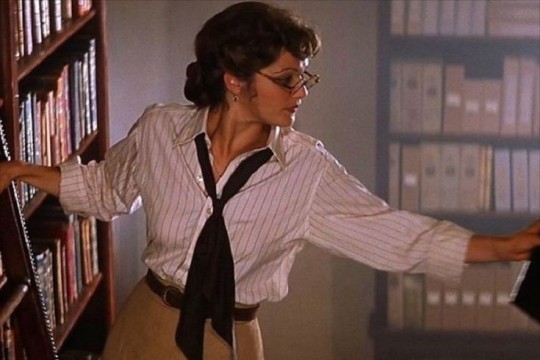
If your character loses their glasses in a fight, they won't be unable to fight back. They can likely still see some things.
Glasses hurt when knocked from your face, you can cut or bruise from a blow to the glasses. (it's happened to me which is why I have a massive scar on my forehead).
Your character will likely dislike going to the optician. Getting your eyes looked into by a stranger with a torch is irritating. Buying new glasses is a long drawn out hellish experience.
Breaking your glasses will upset your character, mainly because they're expensive. A character may opt to get the glasses fixed instead of replaced.
Your character will keep their glasses near at all times. Sleeping, they will be in reach. In the shower, they will be somewhere close by. Glasses may your more confident in your ability so they will always be near.
Also your character will likely not store their glasses in a pocket (they can break) or on their heads (your hair can smudge the lenses).
If your character has one of those early 2000s rom-com moments where their glasses are removed so the world can see their "true beauty", yeah that isn't a thing. Now that person can't fucking see.
Also, your character will likely hate anybody grabbing their glasses or wanting to try them on.
#Characters with glasses#Characters wearing glasses#Writing guide#Writing Characters#Creative writing#writing#writeblr#writing resources#writing reference#writing advice#writers#ask answered questions#writing advice writing resources#spilled ink#Writing reference writing resources#Writing resource writing reference#Writing reference writing resource#Writing advice writing help#Writing help
830 notes
·
View notes
Text
A general cane guide for writers and artists (from a cane user, writer, and artist!)
Disclaimer: Though I have been using a cane for 6 years, I am not a doctor, nor am I by any means an expert. This guide is true to my experience, but there are as many ways to use a cane as there are cane users!
This guide will not include: White canes for blindness, crutches, walkers, or wheelchairs as I have no personal experience with these.
This is meant to be a general guide to get you started and avoid some common mishaps/misconceptions in your writing, but you absolutely should continue to do your own research outside of this guide!
This is NOT a medical resource!!! And never tell a real person you think they're using a cane wrong!

The biggest recurring problem I've seen is using the cane on the wrong side. The cane goes on the opposite side of the pain! If your character has even-sided pain or needs it for balance/weakness, then use the cane in the non-dominant hand to keep the dominant hand free. Some cane users also switch sides to give their arm a rest!
A cane takes about 20% of your weight off the opposite leg. It should fit within your natural gait and become something of an extension of your body. If you need more weight off than 20%, then crutches, a walker, or a wheelchair is needed.
Putting more pressure on the cane, using it on the wrong side, or having it at the wrong height can make it less effective, and can cause long term damage to your body from improper pressure and posture. (Hugh Laurie genuinely hurt his body from years of using a cane wrong on House!)
(some people elect to use a cane wrong for their personal situation despite this, everyone is different!)
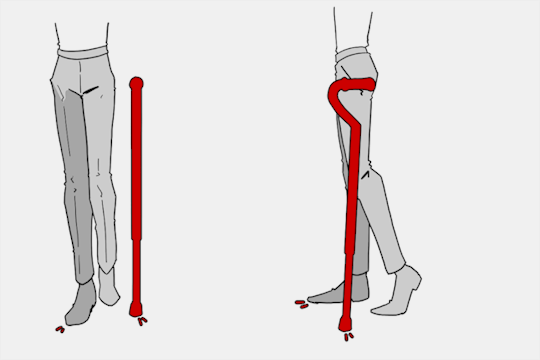
(an animated GIF of a cane matching the natural walking gait. It turns red when pressure is placed on it.)
When going up and down stairs, there is an ideal standard: You want to use the handrail and the cane at the same time, or prioritize the handrail if it's only on one side. When going up stairs you lead with your good leg and follow with the cane and hurt leg together. When going down stairs you lead with the cane and the bad leg and follow with the good leg!
Realistically though, many people don't move out of the way for cane users to access the railing, many stairs don't have railings, and many are wet, rusty, or generally not ideal to grip.
In these cases, if you have a friend nearby, holding on to them is a good idea. Or, take it one step at a time carefully if you're alone.
Now we come to a very common mistake I see... Using fashion canes for medical use!
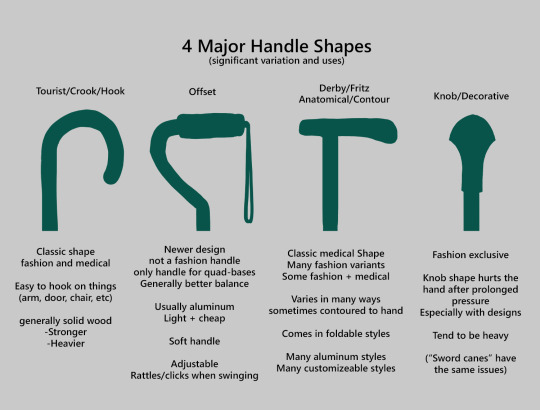
(These are 4 broad shapes, but there is INCREDIBLE variation in cane handles. Research heavily what will be best for your character's specific needs!)
The handle is the contact point for all the weight you're putting on your cane, and that pressure is being put onto your hand, wrist, and shoulder. So the shape is very important for long term use!
Knob handles (and very decorative handles) are not used for medical use for this reason. It adds extra stress to the body and can damage your hand to put constant pressure onto these painful shapes.
The weight of a cane is also incredibly important, as a heavier cane will cause wear on your body much faster. When you're using it all day, it gets heavy fast! If your character struggles with weakness, then they won't want a heavy cane if they can help it!
This is also part of why sword canes aren't usually very viable for medical use (along with them usually being knob handles) is that swords are extra weight!
However, a small knife or perhaps a retractable blade hidden within the base might be viable even for weak characters.
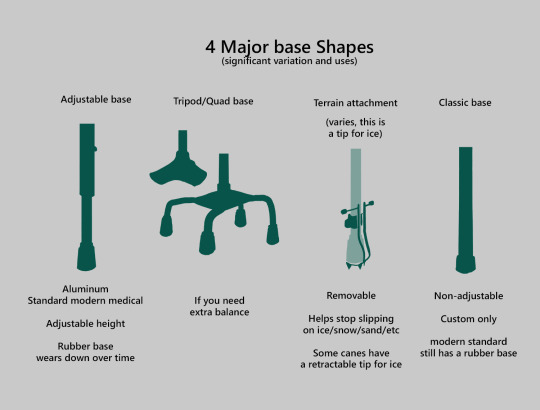
Bases have a lot of variability as well, and the modern standard is generally adjustable bases. Adjustable canes are very handy if your character regularly changes shoe height, for instance (gotta keep the height at your hip!)
Canes help on most terrain with their standard base and structure. But for some terrain, you might want a different base, or to forego the cane entirely! This article covers it pretty well.
Many cane users decorate their canes! Stickers are incredibly common, and painting canes is relatively common as well! You'll also see people replacing the standard wrist strap with a personalized one, or even adding a small charm to the ring the strap connects to. (nothing too large, or it gets annoying as the cane is swinging around everywhere)
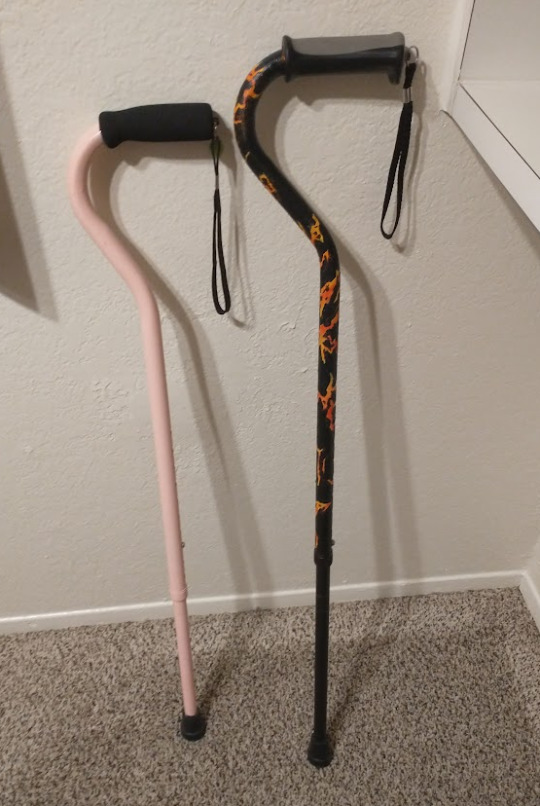
(my canes, for reference)
If your character uses a cane full time, then they might also have multiple canes that look different aesthetically to match their outfits!
When it comes to practical things outside of the cane, you reasonably only have one hand available while it's being used. Many people will hook their cane onto their arm or let it dangle on the strap (if they have one) while using their cane arm, but it's often significantly less convenient than 2 hands. But, if you need 2 hands, then it's either setting the cane down or letting it hang!
For this reason, optimizing one handed use is ideal! Keeping bags/items on the side of your free hand helps keep your items accessible.

When sitting, the cane either leans against a wall or table, goes under the chair, or hooks onto the back of the chair. (It often falls when hanging off of a chair, in my experience)
When getting up, the user will either use their cane to help them balance/support as they stand, or get up and then grab their cane. This depends on what it's being used for (balance vs pain when walking, for instance!)
That's everything I can think of for now. Thank you for reading my long-but-absolutely-not-comprehensive list of things to keep in mind when writing or drawing a cane user!
Happy disability pride month! Go forth and make more characters use canes!!!
#mobility aid#cane user#writing tips#writing advice#drawing tips#art tutorial#art tips#art reference#art resources#art help#my art#long post
73K notes
·
View notes
Text
Words to Use Instead Of...
Beautiful
stunning
gorgeous
breath-taking
lovely
jaw-dropping
pretty
glowing
dazzling
exquisite
angelic
radiant
ravishing
excellent
ideal
sightly
wonderful
elegant
bewitching
captivating
mesmerizing
enthralling
magnetic
impressive
tasteful
charming
desirable
enchanting
Interesting
stricking
unusual
appealing
absorbing
srresting
gripping
riveting
alluring
amusing
exceptional
fascinating
impressive
provocative
prepossessing
exotic
readable
refreshing
entrancing
exceptional
Good
honest
upright
dutiful
enthical
pure
guiltless
lily-white
reputable
righteous
tractable
obedient
incorrupt
respectable
honorable
inculpable
irreprehensible
praiseworthy
well-behaved
uncorrupted
irreproachable
Awesome
wondrous
amazing
out-of-this-world
phenomenal
remarkable
stunning
fascinating
astounding
awe-inspiring
extraordinary
impressive
incredible
mind-blowing
mind-boggling
miraculous
stupendous
Cute
endeaing
adorable
lovable
sweet
lovely
appealing
engaging
delightful
darling charming
enchanting
attractive
bonny
cutesy
adorbs
dear
twee
Shy
modest
sel-effacing
sheepish
timid
way
reserved
unassured
skittish
chary
coy
hesitant
humble
introverted
unsocial
bashful
awkward
apprehensive
If you like my blog, buy me a coffee☕ and find me on instagram! 📸
#writer#writers#creative writing#writing#writing community#writers of tumblr#creative writers#writing inspiration#writeblr#writing tips#writers corner#writers community#poets and writers#writing advice#writing resources#writers on tumblr#writers and poets#helping writers#writing help#writing tips and tricks#how to write#writing life#let's write#resources for writers#references for writers#writers block#ao3 writer#writerscommunity#female writers#writer things
4K notes
·
View notes
Text
Where to Start Your Research When Writing a Disabled Character
[large text: Where to Start Your Research When Writing a Disabled Character]
So you have decided that you want to make a disabled character! Awesome. But what's next? What information should you decide on at the early phrase of making the character?
This post will only talk about the disability part of the character creation process. Obviously, a disabled character needs a personality, interests, and backstory as every other one. But by including their disability early in the process, you can actually get it to have a deeper effect on the character - disability shouldn't be their whole life, but it should impact it. That's what disabilities do.
If you don't know what disability you would want to give them in the first place;
[large text: If you don't know what disability you would want to give them in the first place;]
Start broad. Is it sensory, mobility related, cognitive, developmental, autoimmune, neurodegenerative; maybe multiple of these, or maybe something else completely? Pick one and see what disabilities it encompasses; see if anything works for your character. Or...
If you have a specific symptom or aid in mind, see what could cause them. Don't assume or guess; not every wheelchair user is vaguely paralyzed below the waist with no other symptoms, not everyone with extensive scarring got it via physical trauma. Or...
Consider which disabilities are common in real life. Cerebral palsy, muscular dystrophy, stroke, cataracts, diabetes, intellectual disability, neuropathy, multiple sclerosis, epilepsy, thyroid disorders, autism, dwarfism, arthritis, cancers, brain damage, just to name a few.
Decide what specific type of condition they will have. If you're thinking about them having albinism, will it be ocular, oculocutaneous, or one of the rare syndrome-types? If you want to give them spinal muscular atrophy, which of the many possible onsets will they have? If they have Ehlers-Danlos Syndrome, which one out of the 13 different types do they have? Is their amputation below, or above the knee (it's a major difference)? Not all conditions will have subtypes, but it's worth looking into to not be surprised later. This will help you with further research.
If you're really struggling with figuring out what exact disability would make sense for your character, you can send an ask. Just make sure that you have tried the above and put actual specifics in your ask to give us something to work with. You can also check out our "disabled character ideas" tag.
Here are some ideas for a character using crutches.
Here are some ideas for a character with a facial difference (obligatory link: what is a facial difference?).
If you already know what disability your character is going to have;
[large text: If you already know what disability your character is going to have;]
Start by reading about the onset and cause of the condition. It could be acquired, congenital, progressive, potentially multiple of these. They could be caused by an illness, trauma, or something else entirely. Is your character a congenital amputee, or is it acquired? If acquired - how recently? Has it been a week, or 10 years? What caused them to become disabled - did they have meningitis, or was it an accident? Again, check what your options are - there are going to be more diverse than you expect.
Read about the symptoms. Do not assume or guess what they are. You will almost definitely discover something new. Example: a lot of people making a character with albinism don't realize that it has other symptoms than just lack of melanin, like nystagmus, visual impairment, and photophobia. Decide what your character experiences, to what degree, how frequently, and what do they do (or don't do) to deal with it.
Don't give your character only the most "acceptable" symptoms of their disability and ignore everything else. Example: many writers will omit the topic of incontinence in their para- and tetraplegic characters, even though it's extremely common. Don't shy away from aspects of disability that aren't romanticized.
Don't just... make them abled "because magic". If they're Deaf, don't give them some ability that will make them into an essentially hearing person. Don't give your blind character some "cheat" so that they can see, give them a cane. Don't give an amputee prosthetics that work better than meat limbs. To have a disabled character you need to have a character that's actually disabled. There's no way around it.
Think about complications your character could experience within the story. If your character wears their prosthetic a lot, they might start to experience skin breakdown or pain. Someone who uses a wheelchair a lot has a risk of pressure sores. Glowing and Flickering Fantasy Item might cause problems for someone photophobic or photosensitive. What do they do when that happens, or how do they prevent that from happening?
Look out for comorbidities. It's rare for disabled people to only have one medical condition and nothing else. Disabilities like to show up in pairs. Or dozens.
If relevant, consider mobility aids, assistive devices, and disability aids. Wheelchairs, canes, rollators, braces, AAC, walkers, nasal cannulas, crutches, white canes, feeding tubes, braillers, ostomy bags, insulin pumps, service dogs, trach tubes, hearing aids, orthoses, splints... the list is basically endless, and there's a lot of everyday things that might count as a disability aid as well - even just a hat could be one for someone whose disability requires them to stay out of the sun. Make sure that it's actually based on symptoms, not just your assumptions - most blind people don't wear sunglasses, not all people with SCI use a wheelchair, upper limb prosthetics aren't nearly as useful as you think. Decide which ones your character could have, how often they would use them, and if they switch between different aids.
Basically all of the above aids will have subtypes or variants. There is a lot of options. Does your character use an active manual wheelchair, a powerchair, or a generic hospital wheelchair? Are they using high-, or low-tech AAC? What would be available to them? Does it change over the course of their story, or their life in general?
If relevant, think about what treatment your character might receive. Do they need medication? Physical therapy? Occupational therapy? Orientation and mobility training? Speech therapy? Do they have access to it, and why or why not?
What is your character's support system? Do they have a carer; if yes, then what do they help your character with and what kind of relationship do they have? Is your character happy about it or not at all?
How did their life change after becoming disabled? If your character goes from being an extreme athlete to suddenly being a full-time wheelchair user, it will have an effect - are they going to stop doing sports at all, are they going to just do extreme wheelchair sports now, or are they going to try out wheelchair table tennis instead? Do they know and respect their new limitations? Did they have to get a different job or had to make their house accessible? Do they have support in this transition, or are they on their own - do they wish they had that support?
What about *other* characters? Your character isn't going to be the only disabled person in existence. Do they know other disabled people? Do they have a community? If your character manages their disability with something that's only available to them, what about all the other people with the same disability?
What is the society that your character lives in like? Is the architecture accessible? How do they treat disabled people? Are abled characters knowledgeable about disabilities? How many people speak the local sign language(s)? Are accessible bathrooms common, or does your character have to go home every few hours? Is there access to prosthetists and ocularists, or what do they do when their prosthetic leg or eye requires the routine check-up?
Know the tropes. If a burn survivor character is an evil mask-wearer, if a powerchair user is a constantly rude and ungrateful to everyone villain, if an amputee is a genius mechanic who fixes their own prosthetics, you have A Trope. Not all tropes are made equal; some are actively harmful to real people, while others are just annoying or boring by the nature of having been done to death. During the character creation process, research what tropes might apply and just try to trace your logic. Does your blind character see the future because it's a common superpower in their world, or are you doing the ancient "Blind Seer" trope?
Remember, that not all of the above questions will come up in your writing, but to know which ones won't you need to know the answers to them first. Even if you don't decide to explicitly name your character's condition, you will be aware of what they might function like. You will be able to add more depth to your character if you decide that they have T6 spina bifida, rather than if you made them into an ambiguous wheelchair user with ambiguous symptoms and ambiguous needs. Embrace research as part of your process and your characters will be better representation, sure, but they will also make more sense and seem more like actual people; same with the world that they are a part of.
This post exists to help you establish the basics of your character's disability so that you can do research on your own and answer some of the most common ("what are symptoms of x?") questions by yourself. If you have these things already established, it will also be easier for us to answer any possible questions you might have - e.g. "what would a character with complete high-level paraplegia do in a world where the modern kind of wheelchair has not been invented yet?" is much more concise than just "how do I write a character with paralysis?" - I think it's more helpful for askers as well; a vague answer won't be much help, I think.
I hope that this post is helpful!
Mod Sasza
#mod sasza#writing reference#writing advice#writing resources#writeblr#writing disabled characters#writing resource#long post#writing tips#writing guide
2K notes
·
View notes
Text
What to give a fuck about,while writing your first draft!
I`ve posted a list about things you don´t need to give a fuck about while writing your first draft. Here are things you NEED TO CARE about! (in my opinion)
Your Authentic Voice: Don't let the fear of judgment or comparison stifle your unique voice. I know it´s hard,but try to write from your heart, and don't worry about perfection in the first draft. Let your authenticity shine through your words.
Your Story, Your Way: It's your narrative, your world, and your characters. Don't let external expectations or trends dictate how your story should unfold. Write the story you want to tell.
Progress Over Perfection: Your first draft is not the final product; it's the raw material for your masterpiece. Give a fuck about making progress, not achieving perfection. Embrace imperfections and understand that editing comes later.
Consistency and Routine: Discipline matters. Make a commitment to your writing routine and stick to it.
Feedback and Growth: While it's essential to protect your creative space during the first draft, be open to constructive feedback later on. Giving a f*ck about growth means you're willing to learn from others and improve your work.
Self-Compassion: Mistakes, writer's block, and self-doubt are all part of the process. Give a f*ck about being kind to yourself. Don't beat yourself up if the words don't flow perfectly every time. Keep pushing forward and remember that writing is a journey.
Remember, the first draft is your canvas, your playground. Don't bog yourself down with unnecessary worries.
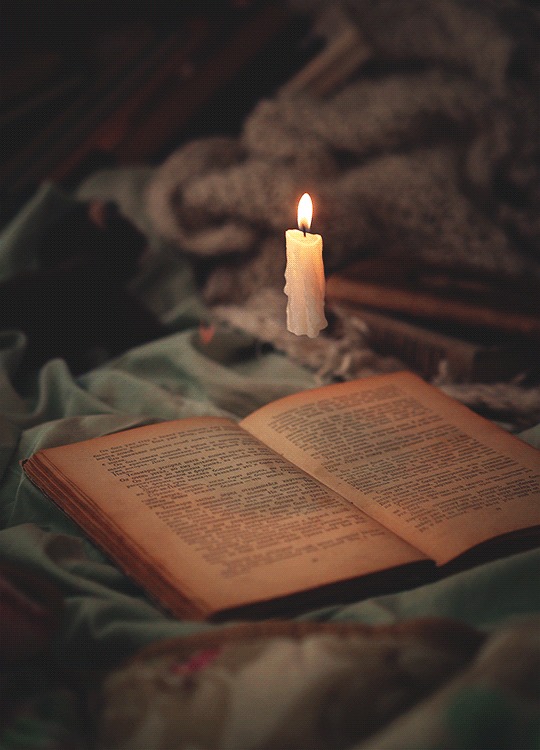
#writing#writblr#writing advice#writers block#just writer things#creative writing#fanfiction writing#writing motivation#writeblr#original writing#writing reference#writing tips#writers on tumblr#writing resources#writing tip#writing encouragement#writing community#writers#world building#point of view#editing#character creation#dialogue#mine.#words#writingtips#writingadvice
4K notes
·
View notes
Text
a list of 100+ buildings to put in your fantasy town
academy
adventurer's guild
alchemist
apiary
apothecary
aquarium
armory
art gallery
bakery
bank
barber
barracks
bathhouse
blacksmith
boathouse
book store
bookbinder
botanical garden
brothel
butcher
carpenter
cartographer
casino
castle
cobbler
coffee shop
council chamber
court house
crypt for the noble family
dentist
distillery
docks
dovecot
dyer
embassy
farmer's market
fighting pit
fishmonger
fortune teller
gallows
gatehouse
general store
graveyard
greenhouses
guard post
guildhall
gymnasium
haberdashery
haunted house
hedge maze
herbalist
hospice
hospital
house for sale
inn
jail
jeweller
leatherworker
library
locksmith
mail courier
manor house
market
mayor's house
monastery
morgue
museum
music shop
observatory
orchard
orphanage
outhouse
paper maker
pawn shop
pet shop
potion shop
potter
printmaker
quest board
residence
restricted zone
sawmill
school
scribe
sewer entrance
sheriff's office
shrine
silversmith
spa
speakeasy
spice merchant
sports stadium
stables
street market
tailor
tannery
tavern
tax collector
tea house
temple
textile shop
theatre
thieves guild
thrift store
tinker's workshop
town crier post
town square
townhall
toy store
trinket shop
warehouse
watchtower
water mill
weaver
well
wind mill
wishing well
wizard tower
#worldbuilding#setting prompts#writer resources#writing inspiration#writing prompts#scene settings#writing reference#writing ideas#prompt list#creative writing#writing community#writer prompts#writing tips#world#fantasy world#fantasy worldbuilding#high fantasy#world building#epic fantasy#writing fantasy
2K notes
·
View notes
Text
List of 400+ Dialogue Tags
Below is a full (but not exhaustive) and updated list of dialogue tags. Dialogue tags are a widely debated topic for writers, some saying you should only use said, others arguing the opposite. You will get no opinion for me—only a list to use as you wish :D
Some words may differ in categories based on context.
Expressing Agreement or Confirmation
Acknowledged, Admitted, Affirmed, Agreed, Apologized, Confirmed, Conceded, Gibed, Professed, Reassured, Verified, Vouched
Initiating or Continuing Conversation
Added, Began, Chimed In, Commented, Continued, Conversed, Discussed, Elaborated, Greeted, Interjected, Offered, Proposed, Remarked, Went On
Making a Declaration or Announcement
Announced, Attested, Declared, Decreed, Emphasized, Enunciated, Proclaimed, Revealed, Stated, Voiced
Formal or Deliberate Communication
Chanted, Concurred, Observed, Postulated, Preached, Put Forth, Reasoned, Surmised, Testified
Indirect Communication
Digressed, Hinted, Implied, Insinuated
Providing Information, Explanation or Speculation
Alleged, Articulated, Asserted, Clarified, Doubted, Equivocated, Explained, Guessed, Imparted, Informed, Lectured, Noted, Predicted, Quoted, Recited, Reported, Theorized
Expressing Doubt or Uncertainty
Doubted, Faltered, Guessed, Hesitated, Pondered, Questioned, Speculated, Wondered, Ventured
Seeking or Giving Advice
Advised, Coaxed, Proposed, Recommended, Remonstrated, Suggested, Supposed, Urged
Animalistic
Barked, Croaked, Growled, Hissed, Hooted, Howled, Hummed, Roared, Snarled
Expressing Discontent or Frustration
Complained, Fretted, Grumbled, Protested, Ranted
Demonstrating Authority or Command
Avowed, Commanded, Crowed, Decided, Demanded, Dictated, Directed, Insisted, Instructed, Maintained, Ordered, Pressed, Proclaimed, Reprimanded
Displaying Confidence or Assertiveness
Asserted, Assured, Boasted, Bragged, Claimed, Piped Up, Pledged, Spoke Up, Told, Vowed
Exhibiting Anger or Aggression
Accused, Bristled, Challenged, Cursed, Erupted, Exasperated, Fumed, Groaned, Huffed, Raged, Seethed, Snapped, Spat, Stormed, Swore, Threatened, Whinged
Displaying Sadness or Despair
Anguished, Bawled, Bemoaned, Blubbered, Cried, Despaired, Grieved, Lamented, Mourned, Sobbed, Wept, Whimpered, Worried
Persuasiveness
Appealed, Begged, Cajoled, Convinced, Persuaded, Petitioned, Pleaded, Prayed
Conveying Fear or Worry
Cautioned, Entreated, Gasped, Quaked, Shuddered, Stressed, Trembled, Warned
Softly or Quietly
Breathed, Called, Crooned, Murmured, Mumbled, Muttered, Sighed, Whispered
Loudly or Forcefully
Bellowed, Boomed, Cried Out, Hollered, Screamed, Screeched, Shouted, Shrieked, Thundered, Wailed, Whooped, Yelled
Demonstrating Disgust or Disdain
Cringed, Gagged, Griped, Groused, Rasped, Scowled, Sneered, Snorted
Expressing Mockery, Disrespect or Sarcasm
Dared, Imitated, Insulted, Jeered, Mimicked, Mocked, Ribbed, Ridiculed, Scoffed, Snickered, Taunted
Doing Annoyingly
Gloated, Goaded, Nagged, Pestered, Provoked, Sassed, Tattled
Emotional or Expressive Communication
Grunted, Mewled, Panted, Quavered, Sniffled, Snivelled, Squawked, Whined, Yowled
Showing Empathy or Comfort
Comforted, Consoled, Empathized, Soothed, Sympathized
Indicating Thoughtfulness or Reflection
Contemplated, Echoed, Mused, Pondered, Recalled, Reflected, Remembered, Reminded, Reminisced, Retorted, Reiterated
Expressing Humour or Amusement
Cackled, Chirped, Chuckled, Giggled, Guffawed, Jested, Joked, Laughed, Quipped
Revealing Information
Confessed, Confided, Divulged, Disclosed, Expressed, Hinted, Revealed, Shared, Spilled, Uttered
In a Flirtatious Way
Bantered, Cooed, Flirted, Joshed, Moaned, Purred, Teased
Demonstrating Surprise or Astonishment
Gasped, Marvelled, Yelped
Indicating Hesitation or Reluctance
Faltered, Hesitated, Stammered, Stuttered
Engaging in a Dispute or Argument
Argued, Bargained, Bickered, Contended, Debated, Disputed, Negotiates, Objected, Rebutted, Shot Back
Showing Enthusiasm or Excitement
Beamed, Blurted, Cheered, Exclaimed, Gushed, Raved, Rejoiced, Sang, Squealed, Trumpeted
Expressing Approval or Praise
Applauded, Complimented, Encouraged, Exhorted, Extolled, Lauded, Praised
Speaking in a Continuous or Repetitive Manner
Babbled, Chattered, Jabbered, Rambled, Rattled On, Repeated
Questions and Answers
Answered, Asked, Cross-examined, Inquired, Implored, Probed. Prodded, Prompted, Queried, Questioned, Quizzed, Requested
Expressing Criticism or Disagreement
Challenged, Chastised, Chided, Condemned, Corrected, Countered, Criticized, Deflected, Demurred, Denounced, Scolded
Negative or Deceptive Communication
Denied, Droned, Exaggerated, Interrupted, Lied
Finishing the Conversation
Concluded, Finished, Thanked
Neutral or Miscellaneous
Admired, Consented, Foretold, Invited, Mentioned, Mouthed, Pointed Out, Replied, Said, Sputtered, Volunteered
Don’t forget our Grand Opening Giveaway starts February 1st/24 on Tumblr, Instagram and slayingfiction.com! You don’t want to miss it!
Happy Writing!
#creative writing#tumblr writers#writing#novel writing#writing advice#fiction#writer#writing community#writeblr#dialogue tag#character dialogue#dialogue#writing reference#reference#writing resources
3K notes
·
View notes
Note
Hi I was wondering if you know of any good resources to get good vintage names that aren’t typical and boring (Fred, Edward, Alfred etc)?
Some of the names in the Santa letters are certainly peculiar and it made me wonder what kind of names those “vintage baby names” lists are leaving out 😜
Thanks! And happy new year 🎊
One place to get a good general overview of what names were like in a certain era is the Social Security Administration's lists of popular names that go back to the 1880s. The further down the lists you go the less common they get. However these are still all names that had at least a few hundred occurrences, so you're not going to have any Gloyds etc..
I personally always try to find names from primary sources (newspapers, census, vital records, etc.) as you're more likely to come across unusual names that don't make the top 200 lists.
Also keep in mind that name popularity varied greatly by location. Just because there were a bunch of Juanitas in Tulsa in 1930 doesn't mean there were that many in Boston.
Honestly if anyone is working on a specific project and needs names from a certain location/era (i.e. you're writing a novel that takes place in London in 1627) feel free to message me and I'd be happy to work with you to compile a list from primary sources. I love this stuff and will use any valid excuse to spend an evening digging through 17th century baptismal records.
#if you buy me a coffee I might even make you a simple custom name generator#I do this for myself all the time because I'm a party person who really likes spreadsheets#names#history#historical fiction#writing resources#asks#@sir-sleepalot#writing reference#character names
2K notes
·
View notes
Text
WWC’s A Beginner’s Guide to Academic Research
We are pleased to present WWC’s A Beginner’s Guide to Academic Research!
This pandemic project has been over 2 years in the making and we hope it will greatly assist any of our readers who are eager to conduct in-depth research but may be at a loss where to start.
Go to the Guide Here
The guide is split into 6 parts:
Introduction and Table of Contents
Part 1: Getting Started
Part 2: Searching for Sources Online
Part 3: Evaluating Sources
Part 4: Navigating Academic Sources
Part 5: Recognizing Your Limits
Each portion of the guide has links to connect to the previous and next sections. While it is possible to view tumblr pages on phones and tablets through the app, we highly recommend viewing this guide via browser on desktop whenever possible. Tumblr page formatting is better suited for browsers and each section is very dense with information, which will make scrolling in the app or on your dashboard difficult.
Future FAQ/ Discussion:
As noted in part 5 of the guide, for the next two weeks, we will be keeping an eye on the notes for this post. If you have further questions or comments about academic research, drop them here and we will select the most pertinent to respond to in a later post.
If you find this guide helpful, we request that you consider tipping the moderators below for the work and time required from conception, to drafting, formatting and debugging. Their ko-fis are listed below:
Rina: https://ko-fi.com/arcanabean
Marika: https://ko-fi.com/5h1njuu
5K notes
·
View notes
Text
free resources to write a novel in 2024
hello hello! it's me, rach!
as the new year approaches, many of us set goals and resolutions - myself included. one of my goals for 2024 is to write a novel (I've been procrastinating on this for quite a long time now). i assume that some of you might have the same goal, that's why I'm writing this post today.
over 2023 i've been releasing some freebies for authors just like me, so I thought I could compile my favorites in this post. hope you find this useful :)
1) the writer's workbook
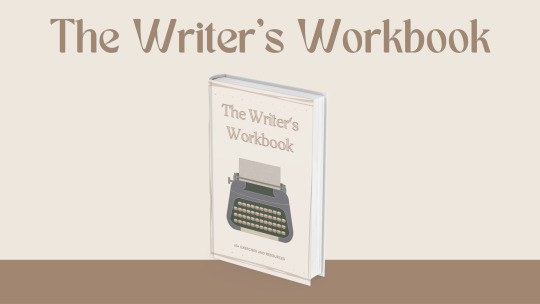
this workbook has over 60 exercises to help you develop characters, scenarios, etc. if you're ever stuck, I'm pretty sure this workbook will be your best friend.
2) author's corner (notion template)

this is the most downloaded freebie in my shop! it is a notion dashboard with everything you need to organize your writing and has some templates included (like scrivener)!!
3) another notion template
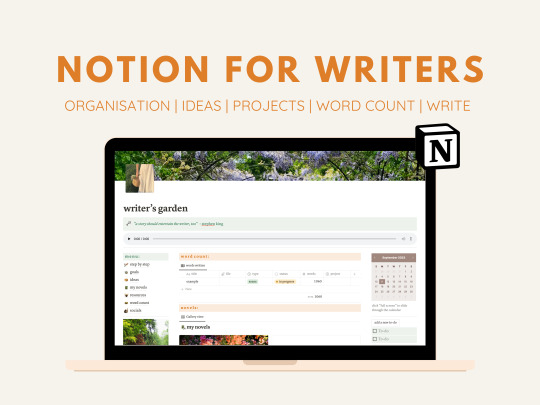
this one has two themes you can choose from: cottage-core and dark academia. they're very similar to the previous template, but this one is more recent and I added some new features. feel free to explore both and pick the one you like the most.
4) the author's journal

this is a cute printable with 20 pages that will help you stay on track and manage your social media accounts as a writer who shares their work online. you can also register what you're currently writing and your personal research and resources.
5) plan your book printable
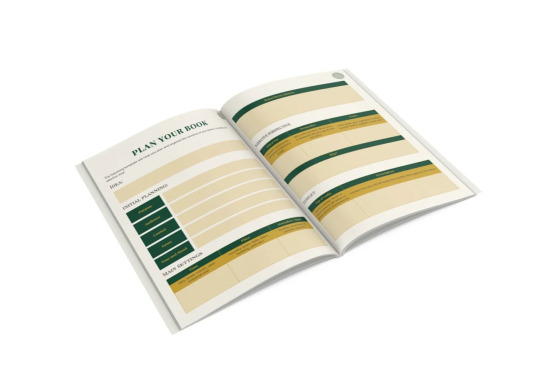
this is a 6-page printable for you to fill out and plan your book easily and effectively.
6) excel sheet to organize tasks & word-count

this is a simple excel sheet, but it is very effective for keeping track of your tasks & word-count of your novels. also, it is 100% customizable to your liking!
that's all for now! feel free to explore my gumroad shop where I have plenty of freebies to grab! also, don't forget to subscribe so that you never miss any opportunity to get a goodie for free :)
hope this post was useful!
have a nice day,
rach
#writing resources#writing#writeblr#writer tips#writing advice#writing help#writing tips#poetsandwriters#resources#research#wattpad#nanowrimo#creative writing#writerscommunity#writers#writing inspiration#writing prompts#writing reference#writerslife#writersofinstagram#software#inspiration#writing inspo#for writing#for writers#for whoever needs it#writing research#researching#we love an useful post#useful
3K notes
·
View notes
Text
Ultimate "Know Your Character Inside Out" Template
The ultimate template for creating a character, without losing your mind, while you're at it.
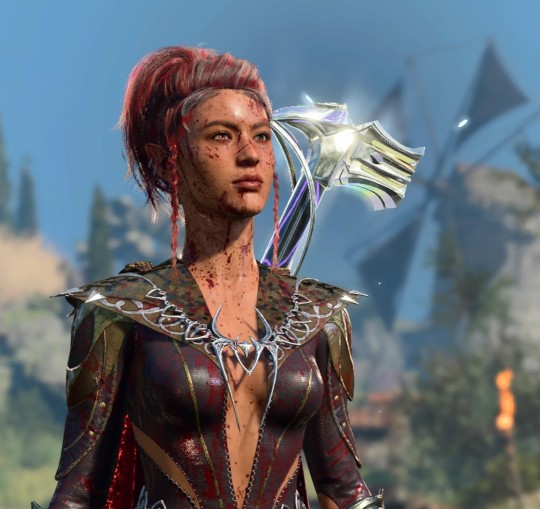
Character Background Template ... (open)
1. Name:
2. Age:
3. Gender & Pronouns:
4. Physical Appearance:
- Hair color:
- Eye color:
- Height:
- Build:
- Distinguishing features (scars, tattoos, etc.):
5. Background and Upbringing:
- Where were they born and raised?
- What was their family structure like (parents, siblings)?
- Describe their childhood environment and upbringing.
- Were there any significant events or traumas in their past?
6. Education and Skills:
- What level of education did they receive?
- Did they excel in any particular subjects or skills?
- Have they pursued any additional training or education since then?
7. Personality Traits:
- Describe their personality in a few words.
- What are their strengths and weaknesses?
- How do they typically react under stress or pressure?
8. Motivations and Goals:
- What are their short-term and long-term goals?
- What drives them to pursue these goals?
- Are there any fears or insecurities that motivate or hinder them?
9. Relationships:
- Who are the most important people in their life?
- How do they interact with family, friends, and acquaintances?
- Do they have any romantic interests or significant relationships?
10. Past Experiences:
- Have they faced any major challenges or setbacks in the past?
- How have these experiences shaped their beliefs and values?
- Have they experienced any significant losses or tragedies?
11. Worldview and Beliefs:
- What are their core beliefs and values?
- How do they view the world around them?
- Are there any cultural, religious, or philosophical influences in their life?
12. Inner Conflict:
- What internal struggles do they face?
- Are there any unresolved issues from their past that continue to affect them?
- How do these inner conflicts impact their decisions and actions?
13. Connection to Outer Conflict/Plot:
- How does their personal journey intersect with the main plot or external conflict?
- What stakes are involved for the character in the larger story?
- How do their goals and motivations align (or conflict) with the central conflict?
(Shorter) Knowing Your Character Inside Out Checklist
Personality Traits:
- Introverted/Extroverted
- Optimistic/Pessimistic
- Assertive/Passive
- Empathetic/Self-centered
- Logical/Emotional
- Adventurous/Cautious
- Honest/Dishonest
- Ambitious/Content
Beliefs and Values:
- Religious beliefs (if any)
- Moral code
- Political beliefs
- Views on relationships
- Attitude towards authority
Fears and Insecurities:
- Common fears (spiders, heights, etc.)
- Deep-seated insecurities (failure, rejection, etc.)
- Traumatic experiences (if applicable)
Desires and Goals:
- Short-term goals
- Long-term aspirations
- What motivates them to pursue these goals?
Strengths:
- Intellectual strengths
- Physical abilities
- Emotional resilience
- Social skills
- Unique talents or abilities
Weaknesses:
- Personal flaws
- Areas of vulnerability
- Bad habits
- Limiting beliefs
Backstory:
- Family background
- Childhood experiences
- Significant life events that shaped their identity
- Education and career path
- Previous relationships
-Josie
#writer community#writing#writing help#character template#original character#character creation#creative writing#writeblr#writerslife#writing community#writers on tumblr#writers of tumblr#writers#writing inspiration#writing prompt#writing prompts#writing tips#writing reference#character prompt#rp template#rp resources#writing advice#writing blog#on writing#writerscommunity#writing template#multiuse#creative process#character creation template#authors of tumblr
1K notes
·
View notes
Text
Fantasy Guide to Building A Culture

Culture is defined by a collection of morals, ethics, traditions, customs and behaviours shared by a group of people.
Hierarchy and Social Structures

Within every culture, there is a hierarchy. Hierarchies are an important part of any culture, usually do ingrained that one within the culture wouldn't even question it. Hierarchy can be established either by age, gender or wealth and could even determine roles within their society. Sometimes hierarchy can may be oppressive and rigid whilst other times, ranks can intermingle without trouble. You should consider how these different ranks interact with one another and whether there are any special gestures or acts of deference one must pay to those higher than them. For example, the Khasi people of Meghalaya (Northern India), are strictly matrillineal. Women run the households, inheritance runs through the female line, and the men of the culture typically defer to their mothers and wives. Here are a few questions to consider:
How is a leader determined within the culture as a whole and the family unit?
Is the culture matriarchal? Patriarchal? Or does gender even matter?
How would one recognise the different ranks?
How would one act around somebody higher ranking? How would somebody he expected to act around somebody lower ranking?
Can one move socially? If not, why? If so, how?
Traditions and Customs

Traditions are a staple in any culture. These can be gestures or living life a certain way or to the way a certain person should look. Traditions are a personal detail to culture, they are what make it important. Tradition can dictate how one should keep their home, run their family, take care of their appearance, act in public and even determine relationship. Tradition can also be a double edged sword. Traditions can also be restrictive and allow a culture to push away a former member if they do not adhere to them, eg Traditional expectations of chastity led to thousands of Irish women being imprisoned at the Magdelene Laundries. Customs could be anything from how one treats another, to how they greet someone.
How important is tradition?
What are some rituals your culture undertakes?
What are some traditional values in your world? Does it effect daily life?
Are there any traditions that determine one's status?
Values and Opinions
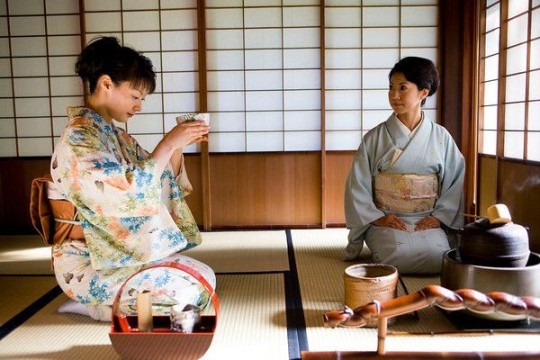
Values and Opinions are the bread and butter of any culture. This is the way your culture sees the world and how they approach different life hurdles. These may differ with other cultures and be considered odd to outsiders, what one culture may value another may not and what opinion another holds, one may not. There will be historical and traditional reasons to why these values and opinions are held. Cultures usually have a paragon to which they hold their members to, a list of characteristics that they expect one to if not adhere to then aspire to. The Yoruba people value honesty, hard work, courage and integrity. Here are some questions to consider?
How important are these ethics and core values? Could somebody be ostracised for not living up to them?
What are some morals that clash with other cultures?
What does your culture precieved to be right? Or wrong?
What are some opinions that are considered to be taboo in your culture? Why?
Dress Code

For many cultures, the way somebody dresses can be important. History and ethics can effect how one is meant to be dressed such as an expectation of chastity, can impose strict modesty. While other cultures, put more importance on details, the different sorts of clothes worn and when or what colour one might wear. The Palestinian people (من النهر إلى البحر ، قد يكونون أحرارا) denoted different family ties, marriage status and wealth by the embroidery and detailing on their thoub.
Are there traditional clothes for your world? Are they something somebody wears on a daily basis or just on occasion?
Are there any rules around what people can wear?
What would be considered formal dress? Casual dress?
What would happen if somebody wore the wrong clothes to an event?
Language

Language can also be ingrained as part of a Culture. It can be a specific way one speaks or a an entirely different language. For example, in the Southern States of America, one can engage in a sort of double talk, saying something that sounds sweet whilst delivering something pointed. Bless their heart. I have a post on creating your own language here.
Arts, Music and Craft

Many cultures are known for different styles of dance, their artwork and crafts. Art is a great part of culture, a way for people to express themselves and their culture in art form. Dance can be an integral part of culture, such as céilí dance in Ireland or the Polka in the Czech Republic. Handicrafts could also be important in culture, such as knitting in Scottish culture and Hebron glass in Palestine. Music is also close to culture, from traditional kinds of singing such as the White Voice in Ukraine and the playing of certain instruments such as the mvet.
Food and Diet

The way a culture prepares or intakes or treats certain foods are important to a culture. In some cultures, there is a diet yo adhere to, certain foods are completely banned. With Jewish culture, pork is prohibited along with fish such as sturgeon, along with shellfish and certain fowl. Meat must also be prepared in a certain way and animal byproducts such as dairy, must never be created or even eaten around this meat. This is known as kosher. The way one consumes food is also important to culture. In some cultures, only certain people may eat together. Some cultures place important on how food is eaten. In Nigerian culture, the oldest guests are served first usually the men before the women. In Japanese culture, one must say 'itadakimasu' (I recieve) before eating. Culture may also include fasting, periods of time one doesn't intake food for a specific reason.
What are some traditional dishes in your world?
What would be a basic diet for the common man?
What's considered a delicacy?
Is there a societal difference in diet? What are the factors that effect diet between classes?
Is there any influence from other cuisines? If not, why not? If so, to what extent?
What would a typical breakfast contain?
What meals are served during the day?
What's considered a comfort food or drink?
Are there any restrictions on who can eat what or when?
Are there any banned foods?
What stance does your world take on alcohol? Is it legal? Can anybody consume it?
Are there any dining customs? Are traditions?
Is there a difference in formal meals or casual meals? If so, what's involved?
Are there any gestures or actions unacceptable at the dinner table?
How are guests treated at meals? If they are given deference, how so?
#Fantasy Guide to Building A Culture#As promised#If I fail my German exam I'm blaming ye#Culture#Building a culture#Fantasy Guide#WorldBuilding#WorldBuilding guide#WorldBuilding help#Writing help#writing#writeblr#writing resources#writing reference#writing advice#ask answered questions#writers#writing advice writing resources#spilled ink#ask answered
8K notes
·
View notes
Text
USEFUL WEBSITES FOR WRITERS
Writing With Color: Helps with writing about culture, ethnicity, and religion. Overall, it gives advice on how to write about diversity.
Name Generator: As the name says, it helps you build names for your characters. Very useful if you cannot think of names for your characters!
KathySteinemann: The 'archive.pdf' section helps you with synonyms in case you struggle to find the right word for your sentences (also to avoid using redundant words).
Spwickstrom: Similar to the previous one, this one provides grammar tips. Extremely helpful when finding phrases, verbs, conjunctions, adjectives, and so on.
Servicescape: The perfect website if you're experiencing writer's block. It provides writing prompts. It helps you spark creativity when it comes to writing.
reblog to help other writers !!
#writerblr#writeblr#writer things#writing#creative writing#writerscommunity#writing tips#writing advice#writing resources#writing help#how to write#writing tips and tricks#writer block#website#resources#for future reference#links#writing prompt#writing prompts
7K notes
·
View notes
Text
Scenes: The Basics🏕️
The Four Chords of a Scene
The scene is a fictional unit that comprises of the following:
Two major chords: Action + Reaction
Two minor chords: Setup + Deepening (be kept to minimum)
A "beat" is a smaller unit within a scene. You can think of this as a paragraph.
1. Action
Action happens when a character does something in order to attain his main objective. In a given scene, he has a scene purpose.
This can include: yelling, shutting the door, fighting, crying, pulling someone back, hugging....basically when your character does something or the other to alleviate the pain or take part in conflict.
2. Reaction
A reaction scene is how a Lead character feels emotionally when something happens to him.
A literary novel may feel like a lot of reaction scens because they are generally more about the interior life of a character.
Reaction is often done in "beats" where the character moves from (1) questioning himself, then (2) providing self-justification to (3) being angry beyond reason, etc.
You can put a "reaction beat" (not a whole scene!) in the middle of action so we know how the character is feeling.
3. Setup
These are things that must occur in order for subsequent scenes to make sense.
All novels need a certain amount of setup to show who the Lead is, what he does and why.
Build in some problem, however slight, to the setup scene. It can be just an alarm ringing or door suddenly opening - something that brings immediacy.
4. Deepening
Deepening is to novel as spice is to food.
This is what you mix to deepen the reader's understanding of character or setting. Make it fresh, drop it in strategically.
Deepening chords are interesting/shocking/fun and kind of in line with the overall theme, but they don't serve a particular purpose.
If you like my blog, buy me a coffee☕ and find me on instagram! 📸
#writers and poets#writing#creative writing#poets and writers#writers on tumblr#helping writers#creative writers#let's write#resources for writers#writeblr#writer#writers#writing community#writers of tumblr#writing inspiration#writing tips#writers corner#writers community#writing advice#writing resources#writing help#writing tips and tricks#how to write#writing life#references for writers
2K notes
·
View notes
Text
A Quick Guide to Colour Symbolism
Colour symbolism has been a long-standing part of the writers' craft. Colours can hold different meanings across various cultures, but here are some common examples of some colours and their associated imagery.
🍎 Red: Love, lust, anger, danger, violence, passion
💎 Blue: Tranquillity, calm, peace, sadness, isolation
🥬 Green: Jealousy, rebirth, growth, greed, renewal
♠️ Black: Death, sadness, loss, grief, evil, depression
🎀 Pink: Sweetness, love, kindness, innocence
🍊 Orange: Joy, creativity, energy, excitement
🌼 Yellow: Joy, cowardice, innocence, optimism
🏳️ White: Innocence, faith, peace, purity, mourning
🐴 Brown: Stability, comfort, predictability, boredom
💟 Purple: Royalty, bravery, virtue, luxury, spirituality
#writers#creative writing#writing#writing community#writers of tumblr#creative writers#writing inspiration#writeblr#writing tips#writerblr#writblr#color meanings#color symbolism#writing advice#writing resources#references for writers#help for writers#writing help#creative writing tips#quick writing tips
3K notes
·
View notes
Text
What not to care about while writing
Writing can be difficult.Here are some basic things i learned to NOT give a fuck about while writing your first draft!
Grammar and spelling in your first draft.
What others might think of your story.
The length of your story; it can be short or long.
Writing every detail - leave room for the reader's imagination.
Whether your story aligns with current trends or popular genres.
Overthinking the title or cover art at the beginning.
Perfect pacing in the initial draft.
The order in which you write scenes - you can rearrange later.
Trying to make every character likable or relatable.
Writing the perfect first draft; let your first draft be really messy.#

#writing#writblr#writing advice#writers block#just writer things#creative writing#fanfiction writing#writing motivation#writeblr#original writing#writing reference#writing tips#writers on tumblr#writing resources#writing tip#writing encouragement#writing community#writers#world building#point of view#editing#character creation#dialogue#mine.#words#writingtips#writingadvice
2K notes
·
View notes